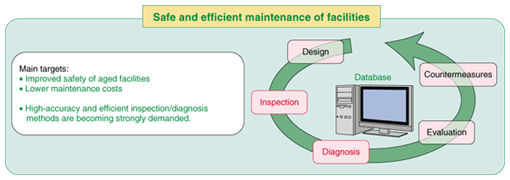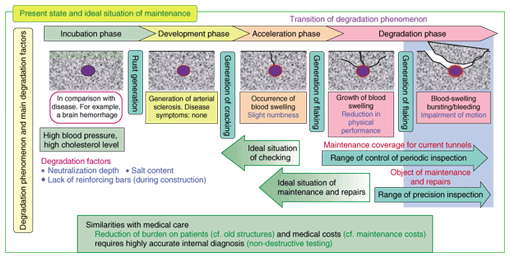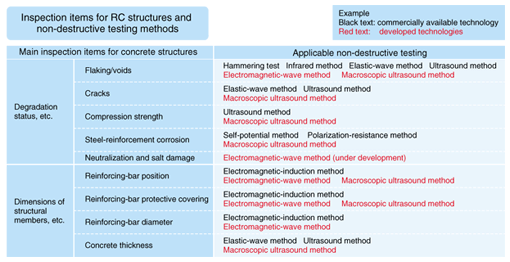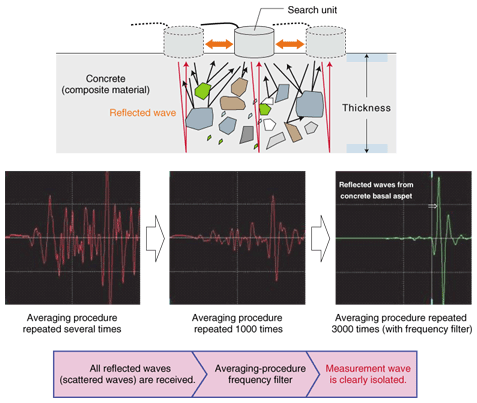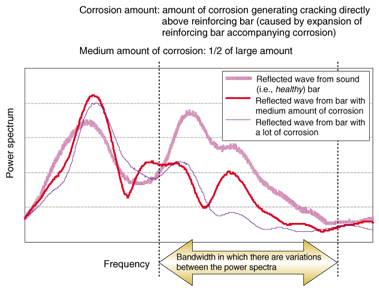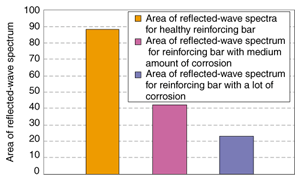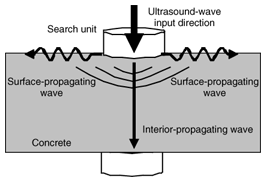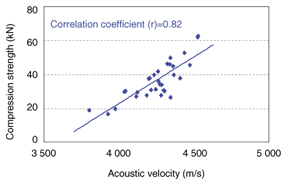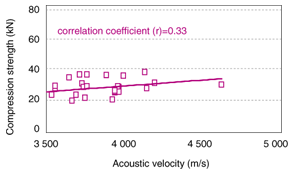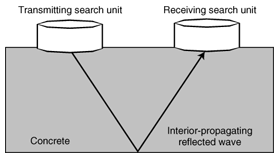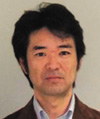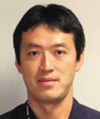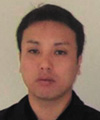 |
|||||||||||
|
|
|||||||||||
|
Letters Vol. 6, No. 5, pp. 34–41, May 2008. https://doi.org/10.53829/ntr200805le3 Non-destructive-testing Methods for Concrete StructuresAbstractThis article describes non-destructive-testing technology using ultrasound being developed at NTT Access Network Service Systems Laboratories for reinforced-concrete structures. Existing techniques can inspect cracking, voids, and other defects in such structures. Our new techniques can estimate the amount of corrosion of steel-reinforcing bars in concrete and the compression strength of the concrete.
1. Importance of non-destructive testingIn present-day Japan, the maintenance and renewal of aging infrastructure—built during the economic boom years—is becoming a major issue. Operating such aged facilities efficiently and safely requires the following maintenance cycle: design, inspection, diagnosis, evaluation, and implementation of countermeasures (Fig. 1). To assure the safety of facilities, it is necessary to ascertain their state to a high degree of accuracy and detail. Moreover, among the steps in the maintenance cycle, the inspection and diagnosis processes are extremely important.
At present, the usual way to inspect and diagnose facilities with high precision is to perform strength testing and material analysis on samples removed from an existing facility. This method, by definition, consumes part of an existing facility, so it is difficult to apply it to the entire structure of an aged existing facility. Furthermore, in large-scale facilities like tunnels, the conditions often vary with the measurement position, so it is difficult to evaluate the condition of the whole facility from local measurements. On the other hand, non-destructive testing evaluates the condition of a structure without damaging it, so it has two advantages: it can be applied to the whole of a large-scale structure and can efficiently evaluate the degradation condition of that structure. The ideal situation and the actual state of the maintenance of steel-reinforced concrete structures are shown schematically in Fig. 2 using the analogy between the degradation process of steel-reinforced concrete and the progress of a disease in humans. In the case of a human disease, if the disease can be detected in its latent phase (i.e., its premorbid phase) by regular health checks, it can be prevented from reaching an acute state, so major surgery is unnecessary. Likewise, in the case of concrete structures, it is important to take effective action at the stage before visible degradation of the concrete occurs. If high-precision facility evaluation by non-destructive testing were available, it would be possible to continue operating and maintaining existing facilities for a long time.
2. Direction of R&D on non-destructive testingThe development of non-destructive-testing technologies at NTT Access Network Service Systems Laboratories is focusing on the concrete structures in NTT's platform facilities (such as existing tunnels and manholes). The methods are mainly based on ultrasound and electromagnetic waves. Ultrasound methods generate sound (elastic) waves in a transmitter placed on the surface of a concrete structure, measure those waves in a receiver also on the concrete surface, and determines the dimensions and position of any internal defects that are detected. These methods search for defects by measuring variations in parameters such as signal arrival time, waveform, frequency, and phase. On the other hand, electromagnetic-wave methods exploit the feature that electromagnetic waves (emitted from a transmitting antenna into the interior of concrete) are reflected at the boundary between the concrete and other materials (e.g., steel reinforcing bar, voids, and underground pipes) that have different electromagnetic properties (e.g., relative permittivity and specific electric conductivity). The distance to the reflecting object is calculated from the propagation time, which enables the object's location to be determined. The main types of degradation that occur in concrete structures and the corresponding non-destructive-testing methods for detecting them are listed in Table 1. At present, there are several non-destructive-testing methods appropriate for each item in concrete structures for inspection. Consequently, an inspection that covers all of these items requires multiple measuring instruments.
To improve upon this situation, at NTT Access Network Service Systems Laboratories, we are developing an inspection method that simultaneously uses ultrasound and electromagnetic waves—which cover a comparatively wide application range—so that less inspection equipment has to be carried to the inspection site. Moreover, we are introducing an acoustic method—called macroscopic ultrasound—that is different from conventional ultrasound methods. 3. Macroscopic ultrasonic methodAlthough the macroscopic ultrasonic method is a commonly used ultrasound method, it has a different measurement principle. Most ultrasound methods for inspecting structures irradiate ultrasonic waves (pulses or bursts) into comparatively uniform materials like steel structures and diagnose the internal condition of the structure from the sound waves reflected from matter with different elastic properties and from transmitted waves that propagate through the structure. When concrete is irradiated with ultrasound waves, however, the waves are scattered by water, voids, gravel, and other things in the concrete, so the received ultrasound waves contain a lot of noise. As a result, it is difficult to identify the desired reflected waves from places like the underside of a concrete structure or from embedded steel-reinforcing bars. Thus, high-precision measurement has not been possible. Our macroscopic ultrasonic method, on the other hand, suppresses noise by sequentially irradiating pulses from an ultrasound search unit as it is moved along a structure in a given time period, and by using a frequency filter*1 to detect arbitrary-component waves and an averaging procedure*2 that averages several thousand pulses. As a result, the reflected waves of interest can be isolated after a few seconds (Fig. 3).
An example of the received waveform when this ultrasonic method is used for measuring concrete thickness is shown in Fig. 3. Here, the reflected waves from the underside of the concrete are clearly isolated by means of a 3000-repetition averaging procedure and a frequency filter. This result clearly shows that it is possible to precisely capture reflected ultrasonic waves from a target within concrete that contains composite materials. This result illustrates why we chose to call this method a macroscopic ultrasonic method: all of the reflected waves (including noise and scattered waves) are received, but the noise is suppressed to reveal the desired reflected waves.
4. Method for estimating amount of steel-reinforcement corrosionThe amount of corrosion of steel-reinforcing bars in a concrete structure must be examined in order to understand their corrosion state and assess the load-bearing performance and durability retained by the concrete. When reinforcing bars in concrete become corroded (i.e., rusted), rust is generated on the surface of the bars, and fine cracks begin to grow as the rusting expands. Ultrasound waves are reflected differently depending on a material's shape and quality. Therefore, we are using this characteristic to develop a method for estimating the amount of corrosion of steel-reinforcing bars in steel-reinforced concrete. An overview of the measurement method is given in Fig. 4. Two wide-bandwidth piezoelectric-element sensors are used to provide separate units for transmitting and receiving signals. During a measurement, to capture reflected waves from a certain region of a reinforcing bar, the separation between the search units is kept constant, and reflected waves are measured while the units are moved parallel to the bar's orientation.
Examples of spectral waveforms that have been Fourier transformed from the reflected ultrasound waves obtained by the measurement method are shown in Fig. 5. This graph indicates that as the amount of corrosion of the reinforcing bars increases, the waves reflected from the structure being examined become weaker across a specific frequency band.
The relationship between the strength of the reflected-wave spectrum and the amount of corrosion was investigated in the following manner. The reflected-wave-spectrum strength is expressed as the area under a spectrum in a certain frequency range, and the amount of corrosion of a steel-reinforcing bar is expressed as the ratio of the bar's weight before and after corrosion. The relationship between them is shown as a bar graph in Fig. 6. This graph indicates that if the area under the reflected-wave spectrum obtained from the non-corroded bar is taken as a baseline, the area under the reflected-wave-spectrum decreases as the amount of steel-reinforcing-bar corrosion increases. Two factors are responsible for this trend. First, the outer diameter of a steel-reinforcing bar is increased by corrosion (because steel expands by two to four times when it turns to rust), which exerts pressure on the surrounding concrete and causes microscopic cracking. Second, rust bonds to the surface of the steel bar, giving it an irregular shape. These factors cause scattering and attenuation of ultrasound waves, which reduce the spectral strength. Furthermore, this phenomenon is prominent in a certain frequency band (see Fig. 5).
5. Method of estimating the compression strength of concreteConcrete structures are designed on the basis of the strength of the concrete, in particular, its compression strength. A change in the physical properties of the concrete due to degradation of a concrete structure affects the concrete's compression strength. Consequently, when diagnosing the condition of concrete, it is especially important to understand the compression strength. We are developing technology that utilizes the special characteristic of ultrasound waves—namely, the direct relationship between their velocity and the elastic modulus*3 of the material through which they are propagating—to estimate the compression strength of concrete from the acoustic velocity of ultrasound waves propagating in the concrete. Acoustic velocity is calculated from the propagation time of an ultrasound wave within a material. Ultrasound waves propagating through a material are categorized into two types (as shown schematically in Fig. 7): waves propagating within the material (hereafter, internal-propagation waves) and waves propagating on the surface of the material (surface-propagation waves). Internal-propagation waves have higher pulsation energy when ultrasound is irradiated directly towards the material interior than surface-propagation waves.
Research performed up until now has shown that when concrete is placed between ultrasound search units (i.e., the transmission method), internal-propagation waves can better characterize the elastic properties of the concrete (Fig. 8). In the case of reinforced-concrete (RC) structures laid in the ground such as manholes and tunnels, however, this transmission measurement method is inapplicable. Accordingly, concrete-compression-strength estimation utilizing the acoustic velocity of surface-propagation waves (from an ultrasound search unit placed on one surface of the material under examination) has been tried. However, the surface layers of concrete and the interior of construction materials contain large variations. As a result, the variation in acoustic velocity is also large, so it has been difficult to estimate the compression strength of an entire concrete structure (Fig. 9).
Given these drawbacks, we applied the special characteristic of our macroscopic ultrasonic method (namely, high-accuracy measurement of reflected waves from a measurement target) to devise an ultrasonic measurement method that uses reflected waves propagating through a material (Fig. 10). Since this measurement method can perform estimations from ultrasound waves propagating through concrete, it can estimate the compression strength of concrete in a similar manner to the above-mentioned transmission method, making it applicable to the evaluation of RC structures buried in the ground.
6. Future plansBy establishing the two methods described above, for estimating steel-reinforcing-bar corrosion amount and compression strength, we have made it possible to check the required items (namely, compression strength) for facility-strength assessment with a single ultrasound inspection device (i.e., RC diagnostic unit). From now on, we will try to make these methods easier to use while accumulating measurement data from actual structures under various environments and verifying measurement accuracy. Moreover, to evaluate the life-cycle cost of RC structures, we will continue this research in parallel with efforts to understand degradation factors (e.g., neutralization, salinity and concentration) by using electromagnetic waves. Establishing these non-destructive testing methods using ultrasound and electromagnetic waves has made it possible to expand non-destructive testing to cover not only NTT's basic infrastructure but also the huge stock of social capital*4 and architectural RC structures. By doing so, we believe that we can achieve more efficient maintenance and operation of such structures and, thus, contribute to the creation of a safer and more secure society.
|
|||||||||||








